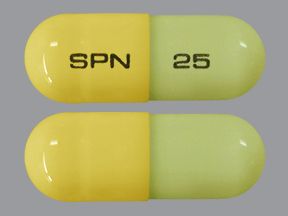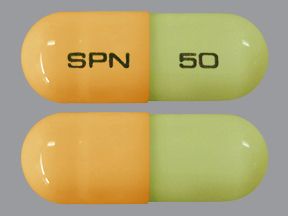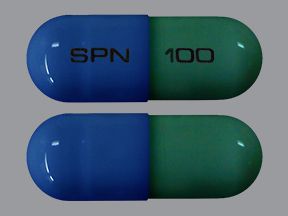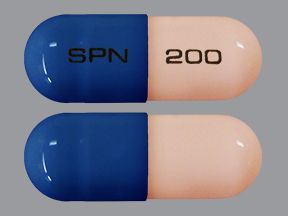If you have certain types of seizure disorders or migraine, your doctor might suggest Trokendi XR (topiramate) for you.
It’s a prescription medication used to treat epilepsy in adults and some children. For epilepsy, Trokendi XR may be used either alone or with another medication to treat:
- partial onset seizures
- primary generalized tonic-clonic seizures
- Lennox-Gastaut syndrome seizures
Trokendi XR is also used to prevent migraine in adults and some children.
This medication comes as an extended-release capsule and belongs to a group of drugs called anticonvulsants.
This article describes the dosages of Trokendi XR, its form, its strengths, and how to take it. To learn more about Trokendi XR, see this in-depth article.
Note: This article covers Trokendi XR’s typical dosages, which are provided by the drug’s manufacturer. But when taking Trokendi XR, always take the dosage your doctor prescribes.
Below is general information about Trokendi XR’s typical dosages for certain conditions. Your doctor or pharmacist will discuss your dosage with you, including how much you’ll take and how often you’ll take it. Be sure to take the exact dosage you’re prescribed, and contact your doctor or pharmacist with any questions.
What form does Trokendi come in?
Trokendi XR comes as an extended-release capsule that you swallow. Extended-release capsules work by slowly releasing their contents in your body.
What strengths does Trokendi XR come in?
Trokendi XR comes in the following strengths:
- 25 milligrams (mg)
- 50 mg
- 100 mg
- 200 mg
What are the typical dosages of Trokendi XR?
Typically, your doctor will start you on a low dosage of Trokendi XR. This is to see how you handle the medication and the prescribed dosage. Your doctor will then adjust your dosage over time to reach the right amount for you. They’ll ultimately prescribe the smallest dosage that provides the desired effect.
The starting dose and maximum dose of Trokendi XR depend on several factors, such as:
- the condition you’re taking the drug to treat
- your age
- your body weight
The information below describes dosages that are commonly used or recommended. But be sure to take the dosage your doctor prescribes for you. Your doctor will determine the right dosage to manage your condition.
Note: The dosages covered just below are for adults. For children’s dosages, see the “What’s the dosage of Trokendi XR for children?” section below.
Dosage for preventing migraine
The starting dosage of Trokendi XR for migraine prevention is:
- 25 milligrams (mg) once per day for the first week
Then, your doctor will likely increase your dose each week depending on how well you respond to treatment. The daily dosage (amount taken once per day) during these weeks is usually increased as follows:
- week two: 50 mg
- week three: 75 mg
- week four: 100 mg
Once you reach the maximum dosage of 100 mg once per day, you’ll likely stay at this dose long term.
Keep in mind these are typical dosage increases for Trokendi XR. Your doctor may increase your dosage more slowly if you experience side effects.
Dosage for treating epilepsy
The starting dose and maximum dose of Trokendi XR for epilepsy depend on several factors, including:
- if Trokendi XR is being used alone or with another medication
- your age
- your body weight
Typically, your doctor will start you on a low dose to see how you respond to treatment.
Trokendi XR dosage when used alone
The starting dose for partial onset or primary generalized tonic-clonic seizures when used alone is:
- 50 mg once per day for one week
After this, the daily dosage (amount taken once per day) is typically increased as follows:
- week two: 100 mg
- week three: 150 mg
- week four: 200 mg
- week five: 300 mg
- week six: 400 mg
If you respond well to Trokendi XR, you’ll likely remain at 400 mg long term. This is the maximum maintenance dosage of this medication.
Trokendi XR dosage when used with another medication
The dosage of Trokendi XR when taken with another medication is based on the type of seizures it’s treating.
The starting dosage is generally 25 mg to 50 mg taken once daily. The dosage is then increased by 25 mg to 50 mg once per week until the maintenance dosage is reached.
The maintenance dosage, taken once daily, depends on the type of seizure being treated. It’s typically as follows:
- for partial-onset seizures: 200 mg to 400 mg
- for Lennox-Gastaut syndrome seizures: 200 mg to 400 mg
- for primary generalized tonic-clonic seizures: 400 mg
What’s the dosage of Trokendi XR for children?
The Trokendi XR dosage for children depends on the following:
- the child’s age
- the child’s body weight
- the condition being treated
- if it’s being taken alone or with another medication
Children’s dosage for preventing migraine
Trokendi XR is used in children ages 12 years and older to help prevent migraine. The dosing schedule for this age group is the same as for adults.
For more information, see “Dosage for preventing migraine” in the “What are the typical dosages of Trokendi XR?” section above.
Children’s dosage for treating epilepsy
The dosage of Trokendi XR varies based on whether it’s used alone or with another medication.
Trokendi XR dosage for children when used alone
The typical dosing schedule for children ages 6 to 9 years is as follows:
- The starting dose is 25 milligrams (mg) of Trokendi XR taken once daily at night for 1 week.
- If your child does well with treatment, their doctor may increase the dosage to 50 mg once daily during week 2.
- After this, your child’s dosage will be increased by 25 mg to 50 mg weekly over the next 5 to 7 weeks, until they reach a maintenance dosage that’s right for the child.
The dosage for your child is based on their weight and will be determined by their doctor. Below is the recommended once-daily dosage range for children, based on weight:
- up to 11 kilograms (kg)* in weight: 150 mg to 250 mg of Trokendi XR
- 12 kg to 22 kg: 200 mg to 300 mg
- 23 kg to 31 kg: 200 mg to 350 mg
- 32 kg to 38 kg: 250 mg to 350 mg
- greater than 38 kg: 250 mg to 400 mg
*1 kg equals about 2.2 pounds.
The dosing schedule for children ages 10 years and above for treating primary generalized tonic-clonic seizures and partial onset seizures is the same as for adults. See “Trokendi XR dosage when used alone” under the “Dosage for treating epilepsy” section above.
Trokendi XR dosage for children when used with another medication
Trokendi XR may be used in children ages 6 to 16 years when used with other medications to treat the following conditions:
- partial onset seizures
- Lennox-Gastaut syndrome
- primary generalized tonic-clonic seizures
For these uses, the recommended starting dose of Trokendi XR is one of the following, taken once each night: 25 mg or between 1 mg and 3 mg per kilogram (kg) of body weight.
If your child responds well to Trokendi XR treatment, their dosage will be slowly increased. The typical increase is 1 mg to 3 mg per kilogram (kg) of body weight every 1 to 2 weeks. Your child’s doctor will adjust the dose to find the one that works best for your child.
The maximum maintenance dosage for children is 400 mg taken once daily.
In some cases, your child’s doctor may round the dosage to the nearest Trokendi XR strength available. They’ll ultimately prescribe the lowest dose that provides benefits without bothersome side effects.
For children ages 17 years and older, the dosing schedule for Trokendi XR when used with other drugs is the same as for adults. See “Trokendi XR dosage when used with another medication” under the “Dosage for treating epilepsy” section above.
Is Trokendi XR used long term?
Yes, Trokendi XR is typically used as a long-term treatment. If you and your doctor determine that Trokendi XR is safe and effective for you, you’ll likely take it long term.
Dosage adjustments
Your doctor may need to adjust your dosage in some cases. Your dosage of Trokendi XR may depend on several factors, such as:
- other health conditions you have, such as kidney problems like chronic kidney disease
- other medications you’re taking with Trokendi XR
- your body weight
- your age
- how well Trokendi XR works to treat your condition
Your doctor will monitor your response to Trokendi XR and adjust your dosage if needed.
Below are answers to some common questions about Trokendi XR dosage.
My doctor just raised my Trokendi XR dose from 50 mg. Can I use extra leftover 50-mg capsules to meet my new dose requirement?
Your doctor will typically start you on a low dose, such as 50 mg, and gradually increase it. Your dose will usually be increased a week at a time. Talk with your doctor about adjusting your dosage to avoid leftover medication whenever possible. You can also ask them or your pharmacist what to do with any unused Trokendi XR capsules.
To avoid taking the wrong dose, follow your doctor’s instructions at all times.
What is Trokendi XR’s dosage for weight loss?
Trokendi XR is not approved for use as a weight loss medication. But weight loss is a common side effect of the drug, especially at higher doses.
Trokendi XR may be used off-label for binge eating disorder.
If you have questions about Trokendi XR and weight loss, speak with your doctor. They can tell you more about the medication and all of its uses.
The dosage of Trokendi XR you’re prescribed may depend on several factors, such as:
- the type and severity of the condition you’re using it to treat
- your age
- your body weight
- if you’re taking Trokendi XR alone or with other medications
- other conditions you have (see “Dosage adjustments” under “What is Trokendi XR’s dosage?”)
Trokendi XR comes as an extended-release capsule you take by mouth. Extended-release capsules slowly release their contents into your body over time. Because of this, you can take them less often compared to regular dosage forms.
You should take Trokendi XR once daily at the same time each day. Ask your doctor or pharmacist about the best time of day to take it. It’s recommended that children take Trokendi XR at night. You can take Trokendi XR with or without food.
Don’t chew, crush, or split your dosage. This can change how Trokendi XR works. If you have trouble swallowing capsules, see this article for tips.
For information on Trokendi XR expiration, storage, and disposal, see this article.
Note: Trokendi XR may not be a good treatment option if you’re on a ketogenic diet (high fat, low carbohydrate). Being on a ketogenic diet while taking this drug can increase your risk of metabolic acidosis and kidney stones. Talk with your doctor about the benefits and risks of Trokendi XR if you’re on this type of diet.
Accessible drug containers and labels
If you find it hard to read the prescription label on your medication, tell your doctor or pharmacist. Some pharmacies may provide medication labels that:
- have large print or use braille
- have a code you can scan with a smartphone to change the text to audio
Your doctor or pharmacist may be able to recommend pharmacies that offer these features if your current pharmacy doesn’t.
If you have trouble opening medication bottles, let your pharmacist know. They may be able to supply Trokendi XR in an easy-open container. Your pharmacist may also have tips that can make it simpler to open the drug’s container.
If you miss taking your regular dose of Trokendi XR, call your doctor. They may ask you to take the missed dose or skip it and take the next scheduled dose. It’s important to take your doses of Trokendi XR according to schedule to manage your condition.
If you need help remembering to take your dose of Trokendi XR on time, try using a medication reminder. This can include setting an alarm or downloading a reminder app on your phone.
Don’t take more Trokendi XR than your doctor prescribes. Taking more than this can lead to serious side effects.
Symptoms of overdose
Symptoms of an overdose can include:
- low blood pressure
- dizziness
- drowsiness
- speech problems
- trouble with coordination
- belly pain
- agitation
- blurred vision
- convulsions
- depression
- death, in serious overdose cases
What to do in case you take too much Trokendi XR
Call your doctor right away if you think you’ve taken too much Trokendi XR. You can also call 800-222-1222 to reach the American Association of Poison Control Centers or use its online resource. But if you have severe symptoms, call 911 (or your local emergency number) immediately or go to the nearest emergency room.
The sections above describe the typical dosages provided by the drug manufacturer. If your doctor recommends Trokendi XR for you, they will prescribe the dosage that’s right for you.
Remember, you should not change your dosage of Trokendi XR without your doctor’s recommendation. Only take Trokendi XR exactly as prescribed. Talk with your doctor if you have questions or concerns about your current dosage.
Here are some examples of questions you may want to ask your doctor about Trokendi XR:
- Would a lower dosage mean I would have reduced side effects?
- Can I take the dosage prescribed for me in two divided doses?
- Is my dosage different if I’m taking it on a ketogenic diet?
- Will my dosage change if I develop kidney disease?
If you take Trokendi XR to help prevent migraine episodes, consider subscribing to Healthline’s migraine newsletter. This resource provides helpful information for managing that condition.
Q:
Would a higher dose of Trokendi XR increase my risk for hair loss?
AnonymousA:
A higher dose of Trokendi XR may increase your risk for hair loss.
In studies, hair loss with topiramate* increased slightly with a 400-mg daily dose compared with a 50-mg daily dose. But the difference was very small, especially in adults. It was slightly more noticeable among children, but hair loss was still rare with either dose in this population.
To learn more about whether your dose of Trokendi XR increases your risk of certain side effects, talk with your doctor or pharmacist. You can also check out the drug’s full prescribing information.
Editor’s note: Topiramate is the active ingredient in Trokendi XR.
Alex Brewer, PharmD, MBAAnswers represent the opinions of our medical experts. All content is strictly informational and should not be considered medical advice.Disclaimer: Healthline has made every effort to make certain that all information is factually correct, comprehensive, and up to date. However, this article should not be used as a substitute for the knowledge and expertise of a licensed healthcare professional. You should always consult your doctor or another healthcare professional before taking any medication. The drug information contained herein is subject to change and is not intended to cover all possible uses, directions, precautions, warnings, drug interactions, allergic reactions, or adverse effects. The absence of warnings or other information for a given drug does not indicate that the drug or drug combination is safe, effective, or appropriate for all patients or all specific uses.




